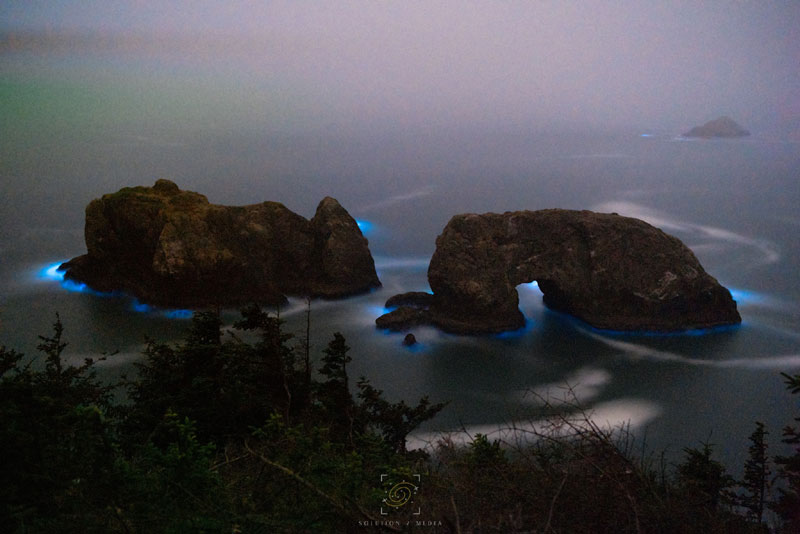Wondrous Odd Science of Oregon Coast: Glowing, Singing, Flashing
Published 3/15/24 at 3:35 p.m.
By Oregon Coast Beach Connection staff

(Oregon Coast) - UPDATED WITH DEEPER DETAILS - The Oregon coast and Washington coast hides some wild 'n' wacky secrets that add a whole new dimension to your getaway. Some are even fairly rare, which only adds to the astonishment factor. (Photo courtesy NOAA)
Includes exclusive listings; some specials in winter
In Cannon Beach:
Includes rentals not listed anywhere else
In Manzanita, Wheeler, Rockaway Beach:
Some specials for winter
In Pacific City, Oceanside:
Some specials for winter
In Lincoln City:
Some specials for winter
In Depoe Bay, Gleneden Beach:
Some specials for winter
In Newport:
Look for some specials
In Waldport
Some specials for winter
In Yachats, Florence
Some specials for winter
Southern Oregon Coast Hotels / Lodgings
Reedsport to Brookings, places to stay; winter deals
Like the green flash at sunset. This scientific oddity was for years a means of ridicule for people claiming to see it, but by the '70s it was actually documented on film.
Under the right conditions, you may see a brief green flash directly above the sun, just before the last sliver dips below the horizon. This can only happen on a day of no clouds, and is the result of a variety of conditions that block out certain color bands for a split second. A little more frequent - but harder to discern - is a slightly longer, green blob that lingers just above the sunset.
There's more to the story, however.

Green flash in Seaside / Oregon Coast Beach Connection
See Oregon Coast's Green Flash at Sunset and Its Wacky Cousin "The green flash is a cousin of an unusual ocean weather phenomenon called the Novaya Zemlya effect. Considered quite a rarity in some ways, it may actually be more common to the Oregon coast than many think."

Green flash at Bayocean / Oregon Coat Beach Connection
Then there are glowing and singing sands.
The singing sands is also very rare and actually happens only on two spots on the coast: in some areas of the National Dunes Recreation Area south of Florence and just south of Cannon Beach. Sometimes, it sounds like distant voices singing. Others, it's a bit like a violin or an odd, elongated squeaking noise. This, too, only happens under certain conditions, when two different kinds of sands grind together under the right degree of humidity.

It's a tiny bit more frequent in the Dunes area than near Cannon Beach. Even so, some that Oregon Coast Beach Connection have talked to on the subject have not heard the phenomenon for years.
Oregon Coast Singing Sands to Booming, Squeaking Sands: How to and Where to Find They're extremely rare and only at the National Dunes Rec Area

Near Gold Beach, courtesy Steven Smith / Solution 7 Media
During spring and summer along the Oregon coast, you'll have a better chance of catching the "glowing sands," although it's still much more common in tropical climates. Here, if you find yourself at the tide line on a really dark beach, you may find a strange, green/bluish spark coming from the sand kicked up by your feet. This is caused by tiny, bioluminescent phytoplankton called dinoflagellates, which glow in a manner not too dissimilar from fireflies.

Near Gold Beach, courtesy Steven Smith / Solution 7 Media
Conditions to look for: a sunny day at the end of a few days of rain and rough seas. This increases the chances of bringing the little fellas to shore.
Bioluminescent Phytoplankton: What Makes Glowing Sand On Oregon Coast, Washington.
For something rather unusual but guaranteed, wait until August and the yearly meteor showers that hit the Earth. While these are easily spotted anywhere on a clear night, cloudless nights on the Oregon coast allow especially crystal clear views of this. It's unforgettable.
Oregon Coast Hotels in this area - South Coast Hotels - Where to eat - Maps - Virtual Tours
Cannon Beach Lodging
Nehalem Bay Lodgings
Manzanita Hotels, Lodging
Three Capes Lodging
Pacific City Hotels, Lodging
Lincoln City Lodging
Depoe Bay Lodging
Newport Lodging
Waldport Lodging
Yachats Lodging
Oregon Coast Vacation Rentals
Oregon Coast Lodging Specials
More About Oregon Coast hotels, lodging.....
More About Oregon Coast Restaurants, Dining.....
 Andre' GW Hagestedt is editor, owner and primary photographer / videographer of Oregon Coast Beach Connection, an online publication that sees over 1 million pageviews per month. He is also author of several books about the coast.
Andre' GW Hagestedt is editor, owner and primary photographer / videographer of Oregon Coast Beach Connection, an online publication that sees over 1 million pageviews per month. He is also author of several books about the coast.
LATEST Related Oregon Coast Articles
Celebrating Oregon Coast Nature, Puffins and Other Beasties at Seaside EventsLove of Puffins on Feb 15, Maine Event fundraiser on Feb 23. Astoria events
Florence's Winter Music Festival Takes Over Central Oregon Coast Jan. 23 - 25
Bluegrass, Americana and a touch of folk. Florence events
Spring Break 2025 on Oregon's North Coast: Winding, Twisting Roads to Differe...
Rollicking times around Seaside, Cannon Beach, Manzanita, Oceanside, Neskowin
Newport's Oregon Coast Jazz Party Announces 2025 Dates: Oct 3 - 5
Now in its 21st year at Newport's Nye Beach. Newport events
Small Travel Impact from Snow in Oregon Coast Range Over Weekend - Portland G...
Brief, minor snow issues in Coast Range as Portland dries up
Vacation Rentals in Cannon Beach: Check Out Reduced Rates at Beachcomber Vaca...
Cannon Beach Specials - reductions in winter and spring. Cannon Beach hotel reviews
Snowy Hazards in Oregon Coast Range as Portland, Eugene, SW Washington Get Du...
Winter storm warning in coast range; snow levels down to 500 feet. Weather
How and When You Might Catch Northern Lights Tonight in Oregon, Washington, t...
Possibly viewable down into Oregon - but what of the weather
Back to Oregon Coast
Contact Advertise on Oregon Coast Beach Connection
All Content, unless otherwise attributed, copyright Oregon Coast Beach Connection. Unauthorized use or publication is not permitted



















































